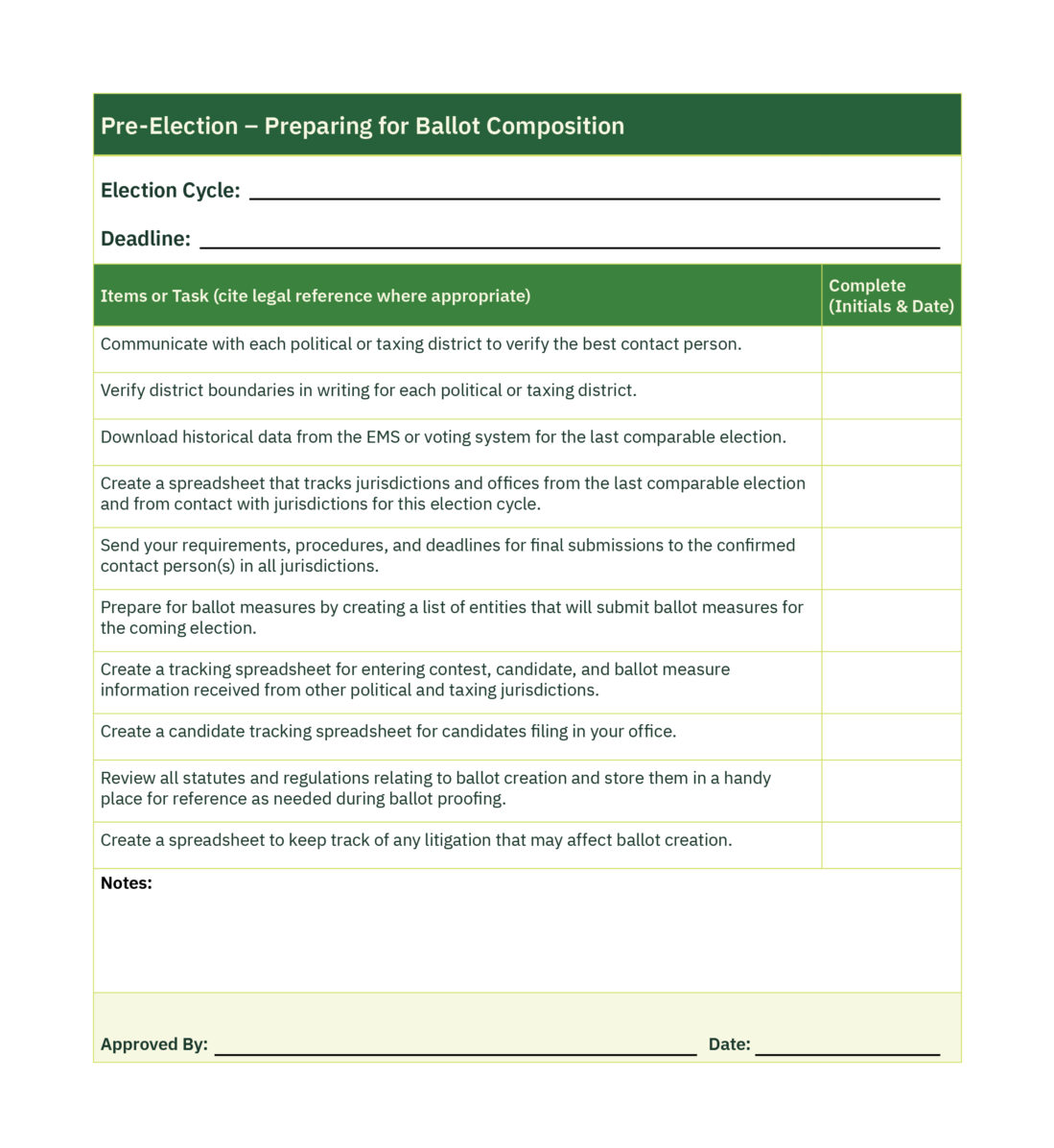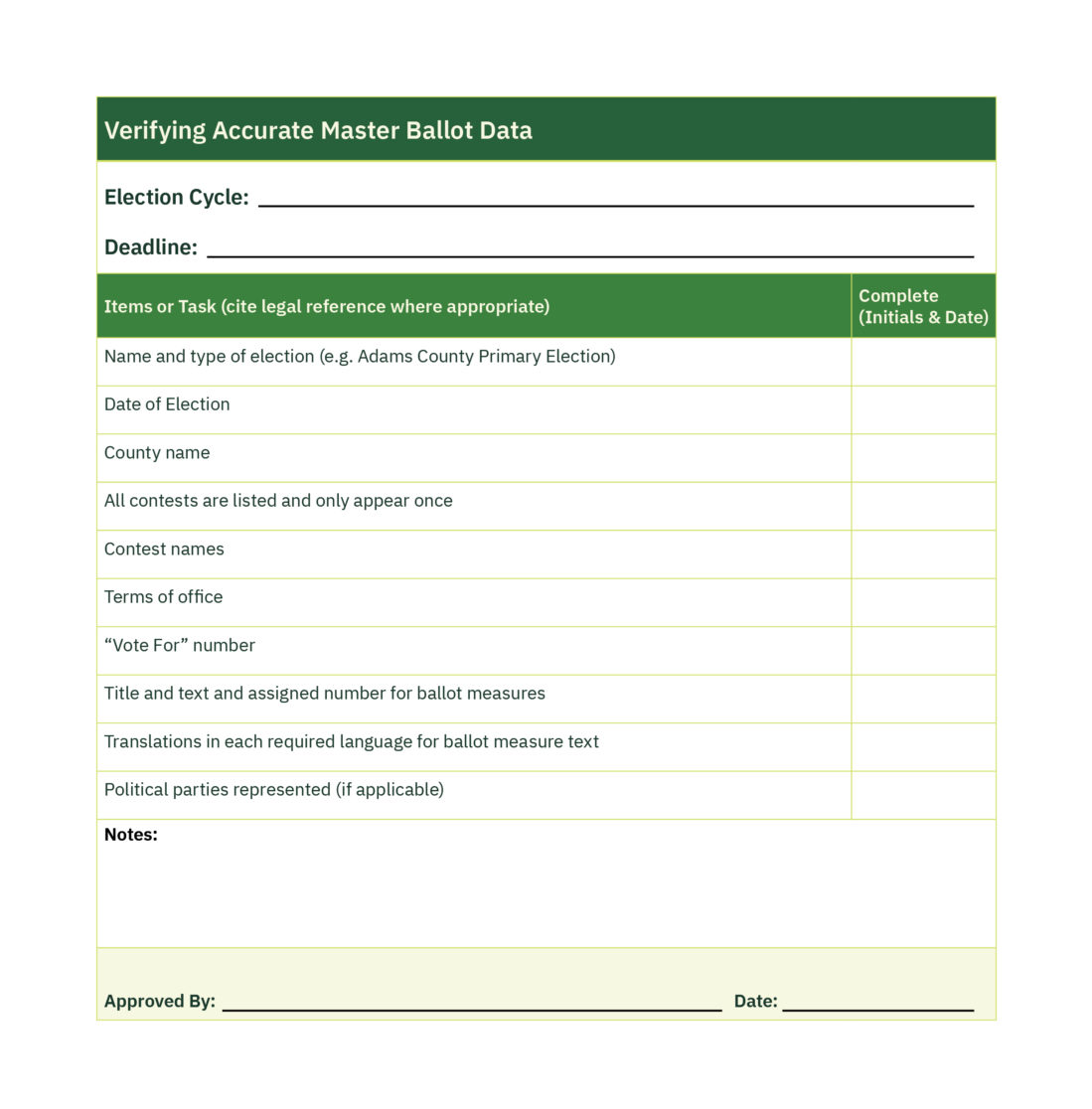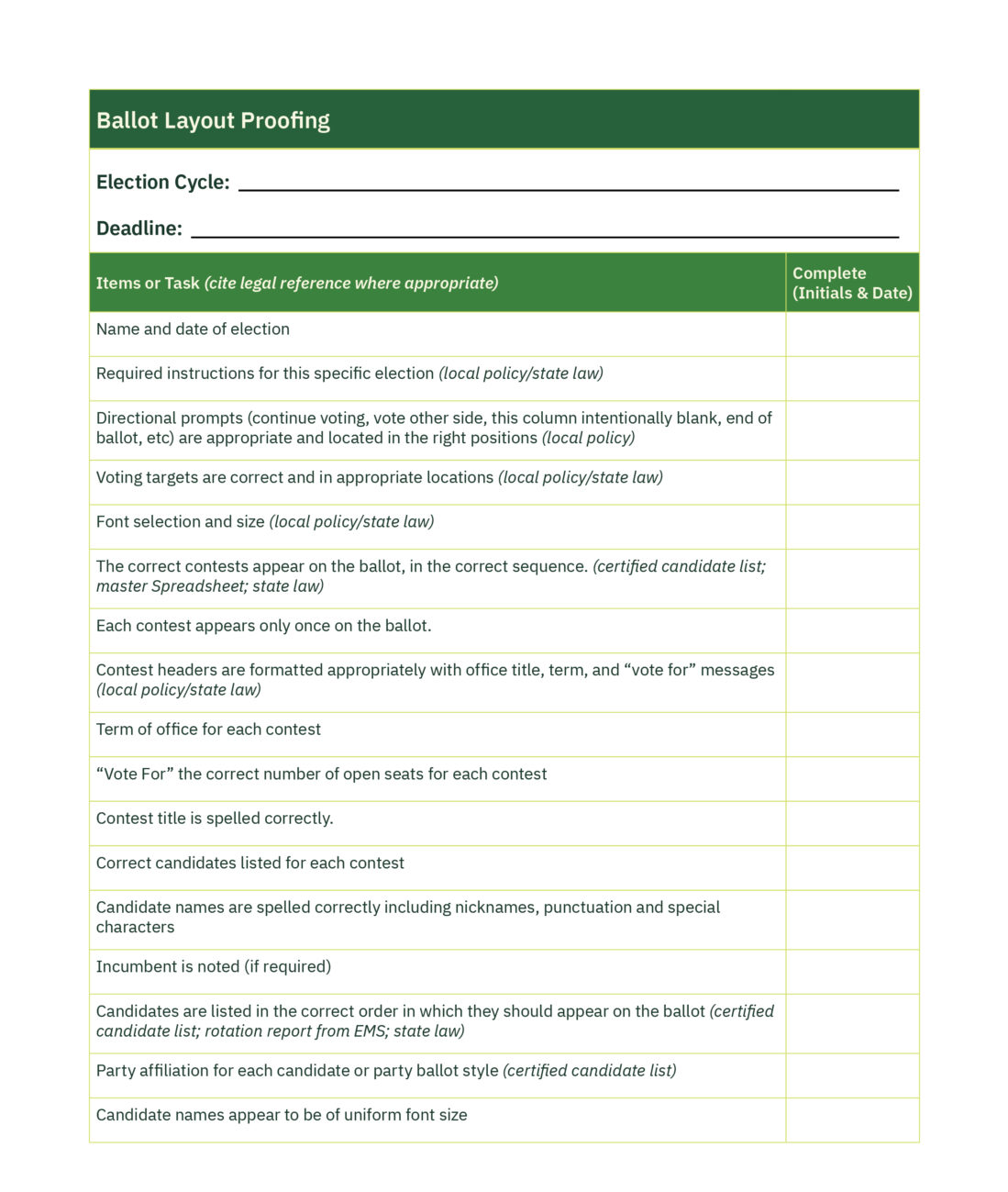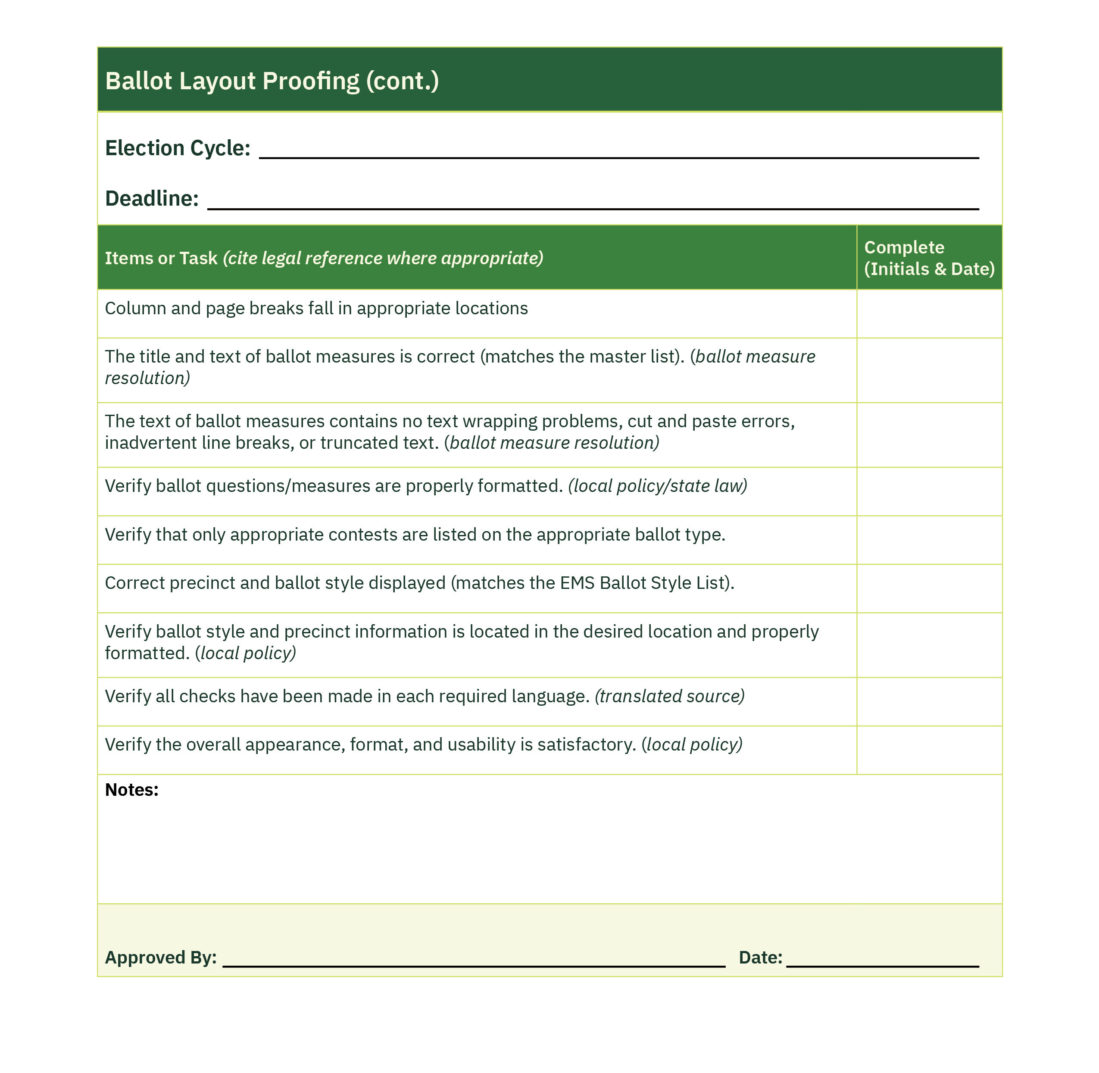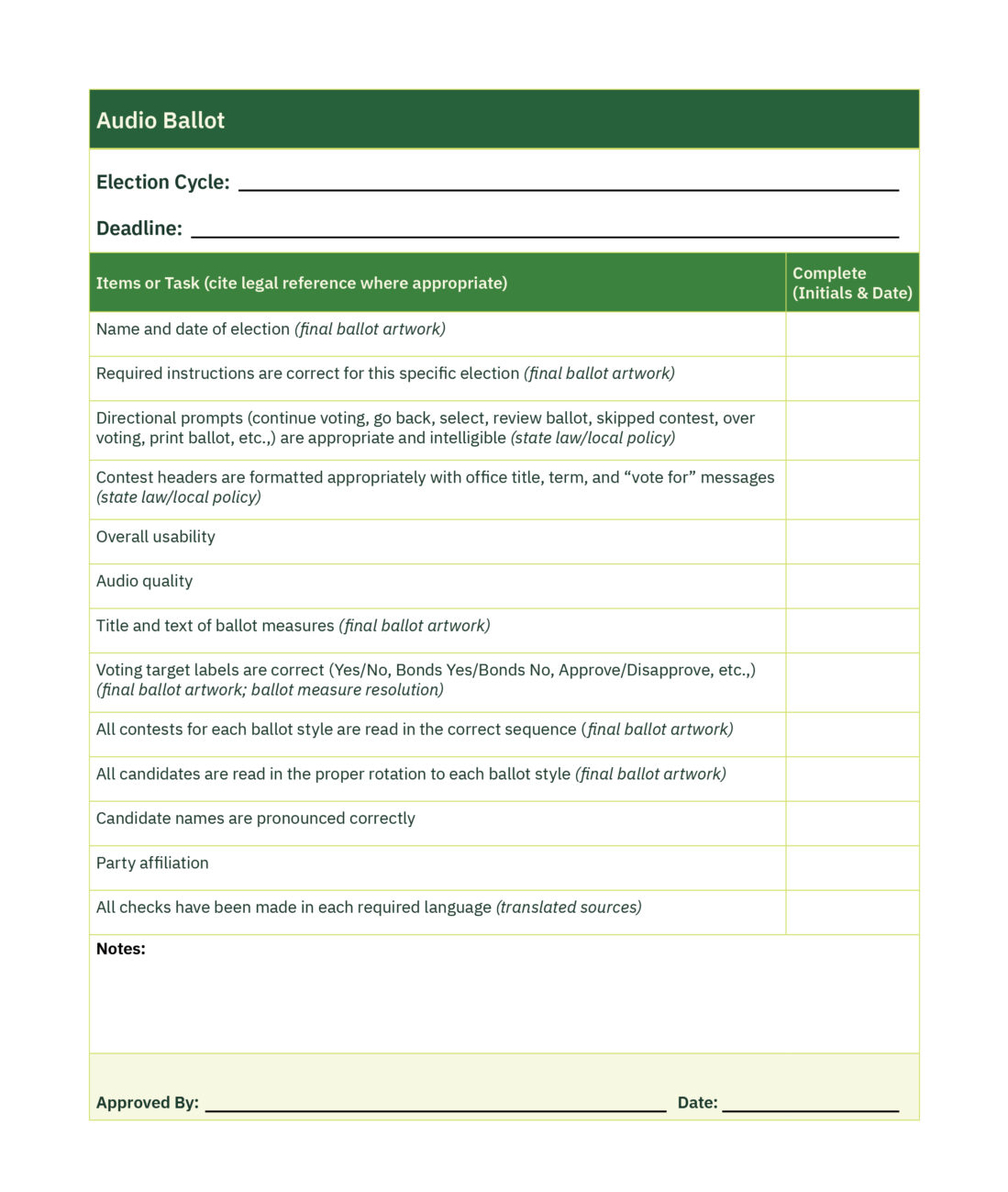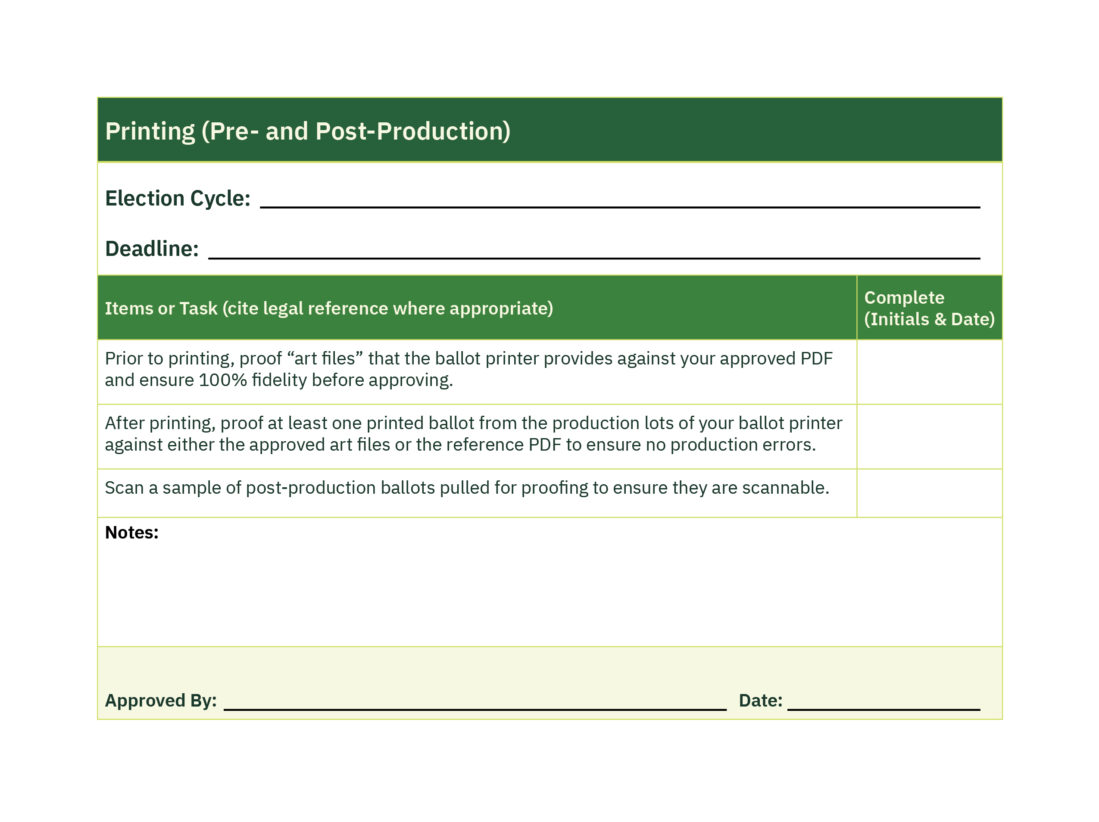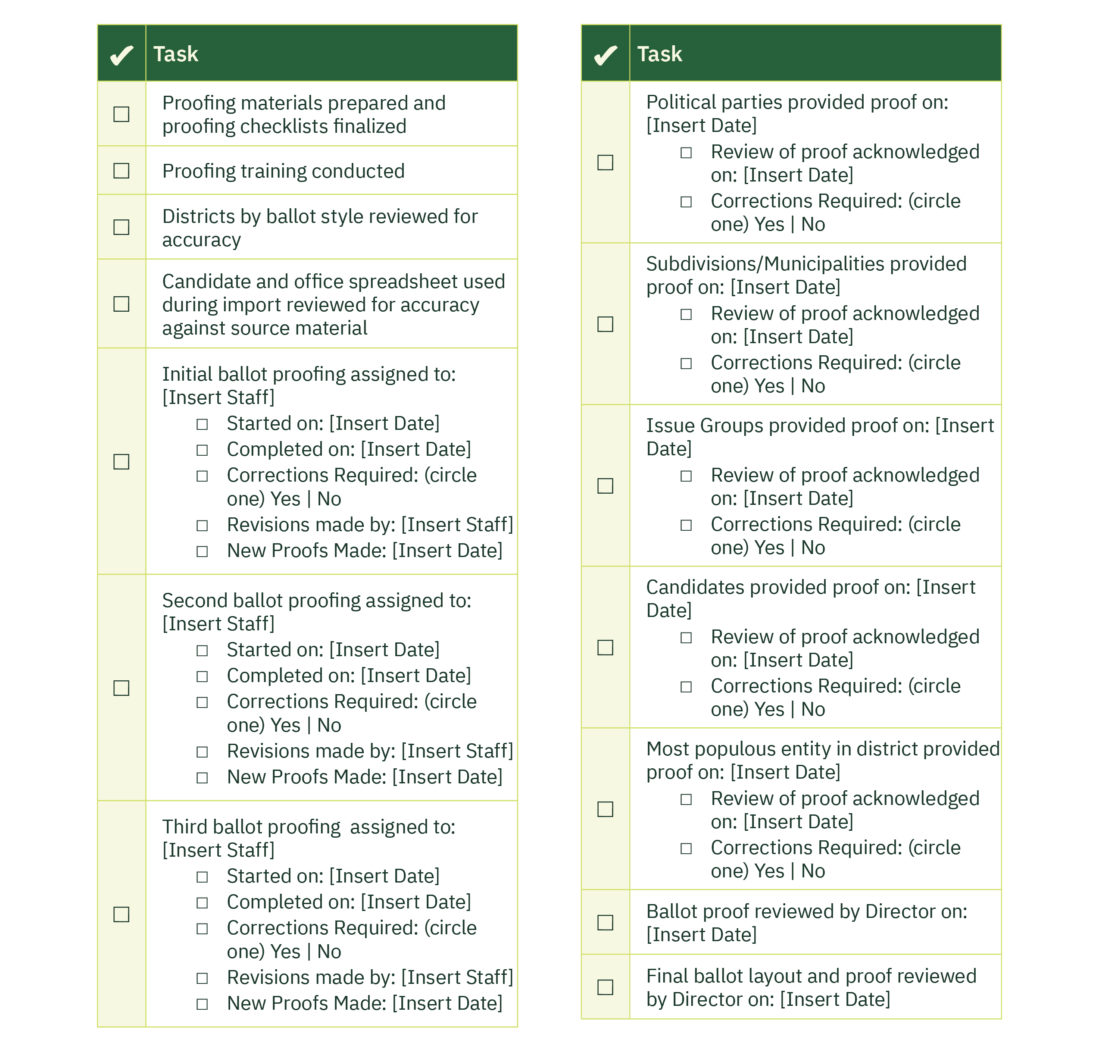February 22, 2024
Ballot Proofing: Ensuring Accuracy in Elections
Download the Resources:
Table of Contents
Jump to:
- Key Principles and Advice
- Understanding the Guide
- Who Should be Involved?
- Proofing Procedure
- Security
- Communications
- Appendices
Key Principles and Advice
- Use strong record keeping practices, including paper and electronic filing systems.
- Rely on primary source documents.
- Communicate with all stakeholders including candidates, other jurisdictions and vested community groups, such as those with members who speak a second language and disability groups.
- Getting it right is more important than being fast.
- Be aware of deadlines and give your team enough time to thoroughly proof ballots.
- Spread the risk. Have multiple ballot proofers that can look with fresh eyes.
- Manage version control. Correct multiple errors at once before producing new proofs. This keeps versions to a minimum and reduces the number of times something needs to be proofed.
Understanding the Guide
Election administration requires precision and accuracy. Generating accurate ballots is critical to running a successful election. A structured approach to ballot proofing will help eliminate common errors that, if left unnoticed, can have a detrimental effect on your election.
Mistakes can have significant costs such as a recent ballot error that was corrected by reprinting and $200,000 in overnight shipping. The headlines in 2022 and 2023 have shown numerous instances of ballot printing, design and fulfillment errors, including contests or candidates left off the ballot, and poor compliance with minority language requirements, all resulting in additional costs for the jurisdictions. Beyond the costs, avoidable mistakes such as ballot errors can shake voter confidence and damage election officials’ reputations. Ballot proofing, the process of ensuring accurate ballots, deserves a high degree of attention.
The purpose of this guide is to assist your jurisdiction with taking a systematic approach to ballot proofing, thereby limiting ballot mistakes. This guide focuses on proofing inputs (the contests and ballot language) and outputs (ballot appearance and function).
While closely related, this guide does not focus on district assignments, logic and accuracy or design principles. However, we recommend the following resources to help with those parts of ballot creation:
This field guide created by the Center for Civic Design provides simple techniques for improving the layout and format of your ballots.
Best Practices for Geo-Enabling Elections
The National States Geographic Information Council published a guide for using geographic information systems to help ensure that voters are correctly placed within their voting districts and given the correct ballot.
Published by The Elections Group, this guide describes the process of logic and accuracy testing for voting equipment and tabulation equipment and provides checklists and best practices.
Who Should Be Involved?
A main principle of this guide is to include all parties in the process of proofing ballots. Ballot creation and proofing involve checking your staff’s ballot creation work against the original filings by candidates and jurisdictions. Deadlines for ballot printing and generating on-screen ballots are tight. Your success requires developing a plan to adequately staff for ballot proofing and to involve all interested parties in the final approval of the ballots.
| Who | Role |
| Staff |
|
| Other County/City Staff |
|
| Vendors |
|
| Language Experts |
|
| Districts (Cities, towns, schools, parks, taxing districts, etc) |
|
| Candidates |
|
| Political Parties |
|
| State Election Authority |
|
Local elections for school boards, municipal councils, and special districts can be a little more complicated. Sometimes within the same district, some seats are four-year terms and others are two-year terms. Some run at-large and some run by district. Be very thoughtful and consider reaching out to your local authorities to validate their election contests for the year ahead.
In this type of spreadsheet, you could also include columns for the filing officer, contact information, and date of last update. Preparing a spreadsheet like this for the first time can take a bit of time, but it is very useful for ensuring that every jurisdiction is regularly contacted and updated and that their contests are included on the ballot when they should be. If your jurisdiction is required to note incumbency for officials running for reelection, you could also track that information in this spreadsheet.
Another area for preparation is reviewing the laws and regulations for ballots in your jurisdiction. Some statutes or administrative codes dictate the order of contests, candidate rotation, font size, headings, instructional text, captions, and many more aspects of a ballot. These are areas that the Legislature or State Election Authority may have changed since the last election. Be sure to have the necessary legal authorities handy for review before ballot creation and during the proofing process.
Likewise, states have various rules for political party recognition and participation in the primary process. Sometimes political parties change whether they wish to have a closed or open primary. Review the political party considerations for ballot creation early in the process.
Sometimes issues that concern ballot creation are involved in court proceedings. For example many jurisdictions have candidate challenges or litigation involving ballot measures. Make sure to stay informed about legal challenges with an eye toward printing and mailing deadlines.
Ballot Proofing Ground Rules
The following sections provide instruction for the mechanics of ballot proofing. At the outset, however, it is essential to fully explain the ground rules so that all proofers follow the same process.
- Prepare for the ballot proofing process well in advance by contacting proofing partners to provide a timeline with tentative deadlines.
- Inform proofers that the proofing process may involve multiple rounds. This is probably most important for your internal staff and any partners within your county or city.
- Provide all proofers with instructions for the aspect(s) (e.g. voting instructions, compliance with statutes and regulations, contests, candidate names, layout, translation, etc.) that they will be proofing.
- If applicable, send stakeholders a copy of any source documents they need to proof against.
- Clear instructions should be provided to all proofers with information on how and to whom errors should be reported.
- Do not allow proofers to flag ballot errors by phone – always require written notice. Using a free tool like Google Forms or an Airtable form for proofers to complete may help track a proofer’s responsibilities and edits.
- Provide a clear deadline for stakeholders (districts, candidates, political parties) to communicate any errors. If that deadline passes and the stakeholder has not responded, your office can move forward with the next phase of ballot preparation. Create a checklist to track the deadlines and receipt of responses from all stakeholders. This documentation can be a useful paper trail in the event that there are disputes later.
An example of a ballot proofing instruction letter is provided in Appendix 4.
Track Progress
Because a thorough proofing process requires multiple levels of review by multiple people, it is a best practice to have a master checklist that tracks progress throughout the process. An example is provided in Appendix 5.
Without a system in place to organize the proofing process, a team can lose track of what work has been done and what remains to be done. The typical response to that uncertainty is to reset and proof everything. Tracking the progress of ballot proofing is as simple as logging the results at a summary level. With this information, a team will be able to avoid the extra work of unnecessary rechecking of everything because they will have a record of what has been done. Furthermore, this information is essential to manage progress and to determine if the pace of work is adequate to meet printing deadlines.
It is also vital to exercise version control. During the proofing process, you may print out multiple copies of the ballot faces to mark them up. Use a date stamp, different colored paper, or some other method to keep track of which version is the current one so that your team does not duplicate efforts or lose track of which tasks have been completed.
Correcting Errors Discovered During Proofing
Plan for an error correction process. The purpose of proofing is to identify errors and correct them. Therefore, a method of tracking and re-verifying ballots through the revisions process is needed. Anticipating the need for corrections on the proofing checklists is an effective method.
Usually, it will be most efficient to complete a first round of proofreading for a particular phase of the process before making any corrections in the EMS. For example, if you are checking that all of the ballot styles have the correct contests included based on the precinct and district boundaries, it is wise to have at least one complete review of all of the ballot styles before going into the election management system to make programming changes. Likewise, it makes sense to wait for the deadline for candidates to complete their review of the PDF files of the ballot faces before making any changes in response. Making corrections for multiple issues at one time can cut down on the number of times you print copies of the ballot PDF file and will help with version control. Also be aware that if you change one thing in the ballot programming, it may change something else inadvertently.
It is vital to keep track of which errors have been corrected. One method of doing this is to physically initial and date the printout where an error has been flagged after it has been corrected. A second reviewer could then go through the pages of errors and double check that all corrections have been made. Requiring the second reviewer to also date and initial each flag improves your paper trail and makes it unlikely that an uncorrected error will slip through the cracks.
It is also a good idea to send a new PDF to any stakeholders who flagged issues during the proofing process and to note that second proofs were sent in the master checklist.
Proofing Procedure
The intricacies of ballot development may differ from jurisdiction to jurisdiction, but the following phases are generally involved.
 |
Pre-election preparation – this phase involves reviewing ballots from comparable elections and communicating with all districts to get an understanding of what contests will be on the ballots. |
 |
Collecting candidate and contest information – during this time, the elections office and all filing offices will be sharing their candidate lists and ballot measure text. |
 |
Compiling master ballot data – in this phase, all ballot data must be checked against the original sources to ensure accuracy. |
 |
Proofing physical ballot layout – this phase of proofing involves looking at PDF files of every ballot face for the election and checking that all content is accurate. |
 |
Proofing audio ballots – during this phase, it is essential that all audio files are reviewed for accuracy. |
 |
Proofing printer files – this proofing phase requires review of the ballot faces to ensure that no errors have been made in production. |
Standardization of the process, meticulous record keeping, and diligent follow-up will help ensure your jurisdiction does not miss items that are supposed to appear on the ballot, and that all information on the ballot matches primary sources.
Below are checklists for each event that might occur in your proofing process, that can be modified as needed. Ensure there is a place to record the name or initials of the person responsible for each checklist and the date the work was performed.
Keep these checklists and other logs related to the ballot proofing process in a place where they can easily be retrieved. Completed checklists and logs are the ideal documentation that proofing was conducted and completed. Unfortunately, in even the best managed processes, errors will get through. When necessary, this documentation is helpful to show that the mistake was not intentional or a result of negligence but of human error in performing an otherwise well thought out and documented process.
One method of keeping track of all of the various external ballot reviewers and stakeholders is to create a Google Form or Airtable form to use when completing their proofing tasks. Such a form could include check boxes for each task you are asking them to review, the ability to attach a scanned copy of any flagged issues, and a field for the reviewer to date and sign that they have completed their review. An example is provided in Appendix 6. When each reviewer submits their form, the results come back into a spreadsheet that can then be used by the election staff to track progress.
Pre-Election – Preparing for Ballot Composition
During this phase, the goal is to get an accurate picture of what should be on each ballot. This means accounting for any legal changes or district boundary changes as well as anticipating which contests will be on the ballot and which jurisdictions will have ballot measures.
Staffing for this phase depends on the complexity of your elections and whether your records are well organized and up-to-date. Understanding what contests to expect on a ballot starts with a comparison to the past elections. For example, the general election ballot for an upcoming presidential year will look pretty similar to the general election ballot for the last presidential year. Likewise, primary election ballots are comparable from presidential cycle to presidential cycle and from nonpresidential cycle to nonpresidential election cycles. Most offices have a 2-year, 4-year, or 6-year term. You may be able to download a list of contests and candidates from your Election Management System (EMS) or voting software for the last several elections to get you started.
Maintaining a spreadsheet that shows each district’s types of candidates, when they were last on the election, and the term of office can help you anticipate when offices will be up for election again. An example is provided below:
| Office Title | Term of Office | Last Elected | Next Election |
| U.S. President | 4 years | 2020 | 2024 |
| U.S. Senator | 6 years | 2022 | 2028 |
| U.S. Senator | 6 years | 2018 | 2024 |
| U.S. Representative Congressional District 1 |
2 years | 2022 | 2024 |
| Governor | 4 years | 2022 | 2026 |
| County Commissioner District 1 |
4 years | 2020 | 2024 |
Local elections for school boards, municipal councils, and special districts can be a little more complicated. Sometimes within the same district, some seats are four-year terms and others are two-year terms. Some run at-large and some run by district. Be very thoughtful and consider reaching out to your local authorities to validate their election contests for the year ahead.
In this type of spreadsheet, you could also include columns for the filing officer, contact information, and date of last update. Preparing a spreadsheet like this for the first time can take a bit of time, but it is very useful for ensuring that every jurisdiction is regularly contacted and updated and that their contests are included on the ballot when they should be. If your jurisdiction is required to note incumbency for officials running for reelection, you could also track that information in this spreadsheet.
Another area for preparation is reviewing the laws and regulations for ballots in your jurisdiction. Some statutes or administrative codes dictate the order of contests, candidate rotation, font size, headings, instructional text, captions, and many more aspects of a ballot. These are areas that the Legislature or State Election Authority may have changed since the last election. Be sure to have the necessary legal authorities handy for review before ballot creation and during the proofing process.
Likewise, states have various rules for political party recognition and participation in the primary process. Sometimes political parties change whether they wish to have a closed or open primary. Review the political party considerations for ballot creation early in the process.
Sometimes issues that concern ballot creation are involved in court proceedings. For example many jurisdictions have candidate challenges or litigation involving ballot measures. Make sure to stay informed about legal challenges with an eye toward printing and mailing deadlines.
Collecting Candidate and Ballot Measure Information
Gathering the information that must be placed on the ballots for each election involves working with various stakeholders. The State Election Authority will provide a certified list of candidates for the federal, statewide, and legislative offices and certified text for any statewide ballot measures. The political and taxing districts for whom you conduct elections will also provide certified lists of candidates and text for ballot measures. And your office is likely a filing officer for various candidate contests and ballot measures. Keeping all of this information organized is paramount. (See Appendix 7 for a chart that shows the sources of ballot data and how best to proof them.)
When preparing summary documents such as lists of candidates or submitting ballot text, it is possible for mistakes to be made. Thus, the best practice is to provide or request copies of filing documents along with the certified information. Each party should feel empowered to ask questions if something looks off. Just a few of the headlines over the past few years demonstrates that errors could be caught early if all of the various stakeholders take an active role in reviewing ballot data when it is collected and transmitted to the county or city elections office that is responsible for preparing the ballots.
The following are common mistakes to watch for:
- The number of open seats for each contest, especially where voters may vote for more than one candidate
- Contests for unexpired terms
- Incumbents, if noting that is required by law
- Cross-county contests
- Political party indicators
- Statutorily-required language or formatting for ballot measures
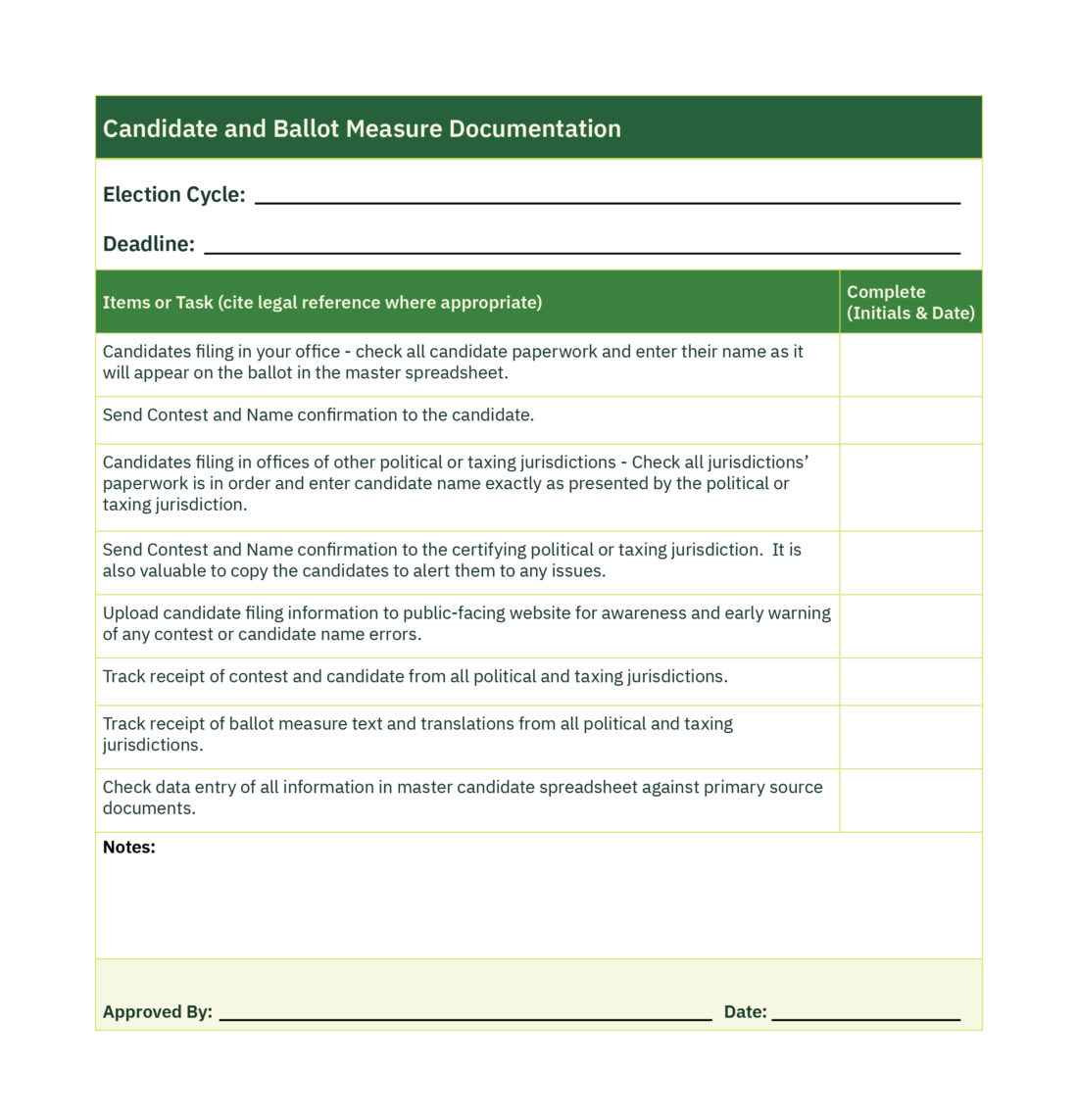
Compiling and Verifying Master Ballot Data
After receiving all ballot data from all filing offices, the next step is to verify that all information has been accurately entered into your master candidate spreadsheet. Some jurisdictions input contest, candidate, and ballot measure information into their voter registration system and then export the information in a file that is then directly imported into the EMS.
Next, it is essential to verify all data against the source documentation. For candidates that filed in your office, check the data entry against the documentation that each candidate submitted. This may include a candidate nomination paper or certificate of candidacy. Be sure to use the most recently received information if your office allows for amendments or if a candidate submitted a change request in response to your candidate confirmation letter.
For candidates that filed with other political and taxing jurisdictions, your primary source documentation may be the certified list of candidates that the district sent. If the districts sent the candidate filing paperwork, be sure to check that documentation as well. If there are any discrepancies, contact the political or taxing jurisdiction immediately to seek clarification in writing.
For ballot measure text, we recommend asking for documentation to be provided in a Word document so that the text can be copied and pasted into the EMS rather than manually typed. This is particularly useful for language translations that may have special characters.
Proofing the Physical Ballot Layout
After your office has entered all of the ballot data for all of the contests and ballot measures, you will generate ballot faces in your jurisdiction’s EMS. This step creates the proper “ballot face” for each party (for a primary election) and precinct or precinct part with its selected contests according to the districts’ boundaries. Each ballot face should have a caption with the name and date of the election, precinct information, and instructions to the voter followed by the contests in the order required by your state’s statutes and regulations. Depending on the number of precincts or precinct splits in your jurisdiction and the number of political parties participating (for a primary election if you use separate ballots), you may have hundreds of different ballot styles. Each one must be reviewed to ensure that the proper contests are displayed and that the ballot complies with all legal requirements.
For this level of review, proofers will be looking at the images of the ballots in any of the following formats:
- PDFs
- Printouts of the PDFs
- Ballot Marking Device (BMD) screens
For ballot faces that are distributed to proofers, apply a watermark indicating that these are draft ballots and/or suppress the timing marks from printing to ensure ballot security.
The comprehensive checklist on the next few pages should be used by internal elections staff and possibly other department staff within your jurisdiction (e.g. county attorney, accounting staff, auditors). For other stakeholders such as the candidates and political and taxing jurisdictions, you may wish to give a much smaller checklist that includes the specific information they need to review and sign off on, such as:
- Contest names
- “Vote for” message
- Candidate’s name spelling
- Candidate order or rotation
- Ballot measure text
- Ballot measure layout (font, heading, yes/no language)
Proofing the Audio Ballot
Whether your office has ADA-compliant voting equipment or you use digital ballots on a remote-voting site, you will likely have to prepare and proof audio versions of your ballots. Programming the audio text may mean using text to speech software in which you must use phonetic language to ensure that pronunciation of names and words are correct.
Proofing audio ballots should be performed by listening to the audio content and following along with the written ballot content.
Some tips for success:
- Ensure the pronunciation is correct for candidate names. If necessary, reach out to the candidate or candidate’s filing officer for a phonetic pronunciation of the name.
- Pay close attention to numbers (dates, dollar amounts, roman numerals, etc.). These often don’t get verbalized correctly by the software, which tries to read them literally.
- Be sure to translate audio content into any languages required for your jurisdiction.
- Your EMS may contain “stock” audio content for instructions to the voter. Thorough proofing should include listening to these instructions to ensure that they are accurate.
Consider inviting students from schools for the blind or those with visual impairments to assist in testing audio ballots, as well as cultural organizations with members who are fluent in other languages – to ensure that appropriate audiences are assisting with the parts of the ballot that they are most likely to interact with and with which they have a vested interest.
Proofing Printer Files
After you have completed all of the previous stages of proofing, you should be ready to send your ballot face PDF files to your printing vendor, if you use one. Before you do, it is a good idea to print several ballots out on a Ballot on Demand (BOD) printer if you have one available, in order to test them on all types of voting and tabulation equipment that you will be using for this election. If you have to make programming changes later on due to equipment issues, your ballot PDFs may be affected and you may need to start over with your print vendor.
The print vendor will likely add various markings on your ballot faces, such as fold marks and ballot stubs. It is important to carefully review every ballot face in the “art file” sent by the printer against your original PDFs to ensure that no errors have been made. Pay careful attention to all data referencing ballot style indicator or precinct information. If you have specific requirements for political party ballots for primary elections (e.g. some jurisdictions use a colored stripe to indicate political party) or indicators for types of ballots (e.g. TEST, EARLY, MAIL, etc.), be sure to check for those as well.
Additional Considerations
It is not the printer’s job to proof your ballot.
When a printer receives a PDF, they generally do so with the assumption that it’s good to go. If the printer needs to make any changes to the artwork file, it should go back to the customer to proof again.
Did you know?
Any change to a ballot file in the EMS will require that you regenerate all ballot files, including the ballot PDFs for printing and the digital files for your voting machines. These will all need to be reproofed, including rechecking the audio. If this is not done, ballots may not be read – or worse, read incorrectly. Redo your logic and accuracy (L&A) process if any changes are made after L&A takes place.
Common Mistakes to Avoid
These are common mistakes we have seen. We wrote this guide to help election officials avoid making them!
- Leaving a candidate’s name or contest off the ballot.
- Confusing “Vote For” instructions (e.g., putting “Vote for One” when it should be “Vote for Two”)
- Misspellings
- Incorrect versions of referenda
- Incorrect order (ballot rotation) of candidates
Security
As with all aspects of election administration, every jurisdiction should develop and maintain strong security procedures that prevent breaches and mitigate the possible impact of any such breaches.
- If your jurisdiction uploads ballot data using a .csv or similar file, use best practices for USB drives or similar portable data devices. The Cybersecurity & Infrastructure Security Agency (CISA) has developed guidance on using caution with these devices as well as properly disposing or wiping information from these devices.
- If your ballot is built on a voting system housed in a secured room, it is essential that access to such a room require two staff members. Access to this room should be restricted only to those requiring it.
- If your voting system is not in a secured room, take necessary steps to secure it as soon as possible.
- Do not share primary ballot files with any outside parties – aside from your printing vendor if you outsource printing operations.
- Watermark with “proof” or “sample” any ballots that are shared with outside stakeholders and render the ballot unreadable by removing the timing marks or barcode.
Communications
If a mistake is made and not caught during the proofing process, be forthcoming. A concise release to media in your area, outlining the issue and the steps that will be taken to rectify it, should be issued as quickly as possible after discovering the issue.
Example Press Release
April 16, 2030
GOTHAM CITY, USA – About 1,200 voters will be affected by an error in the contest of City Clerk for Gotham City’s 2030 Municipal Election.
Ballots mailed to 1,234 voters on April 14 did not include all candidates for City Clerk.
All voters affected will be individually mailed a notice of the error with additional information and instructions.
Additional processes are being instituted to prevent similar issues in the future.
For more information, contact the Gotham City Clerk’s Office at 123-456-7890 or via email at elections@localelectionadministrator.com.
###
A limited number of team members, generally one or two, should be authorized to speak regarding the issue. Like the content of the press release, any messages to the media should be concise and consistent. Briefly describe the issue and highlight the steps that are being taken to fix the issue and ensure that it does not happen again in the future.
For more guidance on how to handle communications strategy for a ballot error, see our Crisis Communication Plan resource.
Appendices
Appendix 1: Sample language for Memorandum of Understanding or Intragovernmental Agreement
This intragovernmental Agreement (“Agreement”) is entered into by and between ABC County Clerk and Recorder (“Clerk”) and the XYZ School District (“Entity”). Agreement is made effective upon the signature of Clerk and Entity.
Clerk and Entity agree as follows:
Duties of Entity
Ballot Preparation
Prepare a list of candidates and the ballot text and title for each ballot measure and provide a certified copy of the ballot content (contests and measures) by no later than 5:00 p.m. on the Xth day before the election.
For ballot measures, Clerk requires that each ballot measure be not more than 200 words in accordance with State Statute. Entity will provide translations into Spanish and Chinese as required by Section 203.
Entity must provide certified ballot content in Microsoft Word format (.doc or .docx) as an attachment to an email to clerk@abccounty.gov
Proofread and approve Entity’s ballot content for printing immediately upon receipt from Clerk. Entity must designate a person to be available for proofing and approving ballot content for printing.
Appendix 2: Template Election Preparation Letter to Districts
This template can be customized and used to communicate with any districts for whom your office conducts their election. If you keep track of current elected officials for each district or if you must denote incumbency on the ballot for candidates running for reelection, you may also want to include that information to ensure that it is accurate. You could also add a section to ask whether the district expects to have a ballot measure on the ballot, and if so, provide a date when ballot text and translations are due. Requiring a response from each district in writing will help resolve any disagreements that may arise.
Dear [District Point of Contact]:
In preparation for the 2024 Election Cycle and in accordance with the Memorandum of Understanding dated May 1, 2020, the following are the official election dates: [insert dates and types of elections]
To assist with our preparation, please confirm or correct the following information:
Boundaries:
According to our records, the legal description for Johnson County Mosquito Board is [insert legal description] and the map file that we have on record is dated [insert date].Response:
The boundary information is correct.
The boundary information needs to be updated. A copy of our updated legal description and/or map file is attached.
Candidate Contests:
The Johnson County Mosquito Board has 2 seats open for 4-year terms and 1 seat open for a 2-year term on the general election ballot for November 5, 2024.Response:
The candidate contest information is correct.
The candidate contest information needs to be updated. A written statement of our contests for the 2024 General Election is attached.
Please check the appropriate boxes above and if necessary, provide additional documentation for the District’s boundaries and/or candidate contests. Sign, date and return this letter by [insert date]. Thank you for your assistance with election planning.
Appendix 3: Template Confirmation Letter to Candidate
Sending a written confirmation of how each candidate’s name will be listed on the ballot allows candidates an opportunity to address any issues early in the process. Note, you may want to discuss with your jurisdictions whether you will send a letter directly to candidates who file candidate paperwork with their office.
Dear [John Doe],
Thank you for qualifying as a candidate for the [office of Clerk & Recorder] in the [2028 General Election]. Our team looks forward to working with you as you take on the exciting challenge of running for public office.
Your name will appear on the ballot as follows:
[John Doe]
[Clerk & Recorder]Please ensure that this information is correct.
If you have any questions, please contact my office at [123-456-7890] or
[elections@localelectionadministrator.gov]Thank you in advance for your consideration of this correspondence.
Appendix 4: Ballot Proofing Instruction Letter
Dear ________,
Thank you for your partnership as we work together to finalize the ballot for the upcoming election.
[Attached or via link] you will find the ballot proof for this upcoming election. Please inspect carefully to ensure that the information for the offices or issues you are responsible for are correct.
Here are the aspects of the offices and candidates to verify for accuracy whenever possible from the source documentation (e.g., petitions, resolutions, etc.): :
- The office title
- The term type (e.g., Full Term or Unexpired Term)
- The number of candidates to be nominated or elected (e.g., Vote for ________)
- The correct number of candidates are included
- The spelling of each candidate’s name
- The proper rotation of candidate names
- The write-in line (determine if it news included)
- If more than once office, the order in which they appear
Here are the aspects of the issues to verify for accuracy:
- The issue title
- The text of the issue matches original documentation
- The font size and type (bold, normal, italic)
- The response text (e.g., For, Against, Yes, No, etc.)
- The placement of the issue on the ballot including the order any rotation that is required
- The text wrapping of any issue from one column to another
Please contact our office by ________ noting any errors or corrections that are required. We will provide another proof once any corrections have been made.
If you have any questions, please contact ________.
As a reminder, you have until ________ to respond.
Your prompt attention to this is appreciated.
________ Elections Office
Appendix 5: Master Checklist
The purpose of the master checklist is to provide the person (or persons) supervising the ballot proofing with a means to verify the process was completed. Use this to create your own to ensure no key steps are missed.
Appendix 6: Google Form to Proofer
Google forms are easy to create. You need a google email account to begin. Figuring out how to set up specific types of questions is intuitive but also supported by many how-to guides. Below is a suggested template for sending a ballot proof to a candidate.
First create an introductory paragraph explaining how the Google form will be used. Then continue with the specific questions that you want the reviewer to answer. You can also allow the reviewer to upload a PDF that is marked up with their requested corrections. The responses to a Google form are collected in a spreadsheet and are accessible by the author of the form, but can also be shared with others in the election office, if needed.
You could send each candidate an email containing a link to the Google form, a PDF of the ballot proof(s), and a PDF of their candidate filing documentation.

Appendix 7: Election Data Table
| Data Source | Method of Data Transfer | Best Practices |
| State Ballot Data Scenario 1 |
Scenarios 1 and 2 are not mutually exclusive. |
|
| State Ballot Data Scenario 2 |
Scenarios 1 and 2 are not mutually exclusive. |
|
| County or Jurisdiction-wide Ballot Data |
|
|
| Political and Taxing District Ballot Data |
|
|
Download the full Ballot Proofing Guide: Ensuring Accuracy in Elections (PDF)
Watch our webinar on Proofing Ballots for Perfection: Tips for Mistake-Free Ballots


